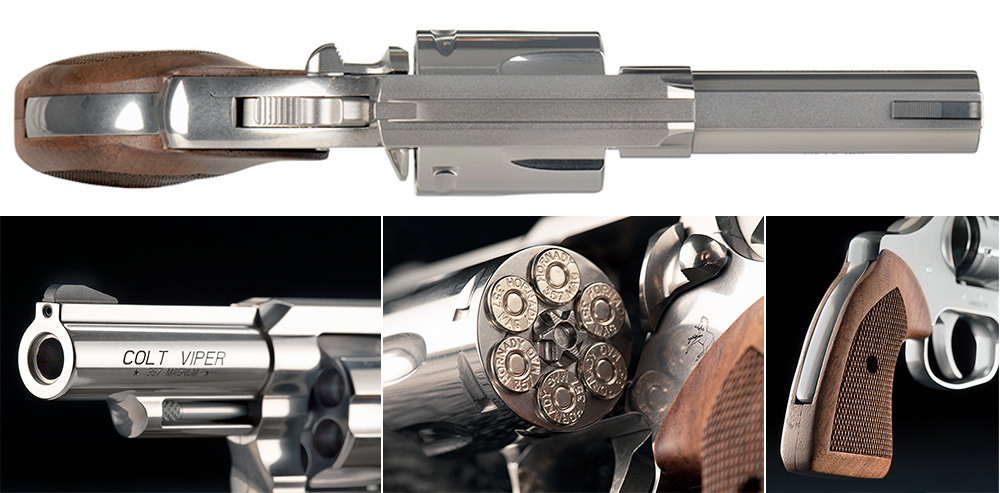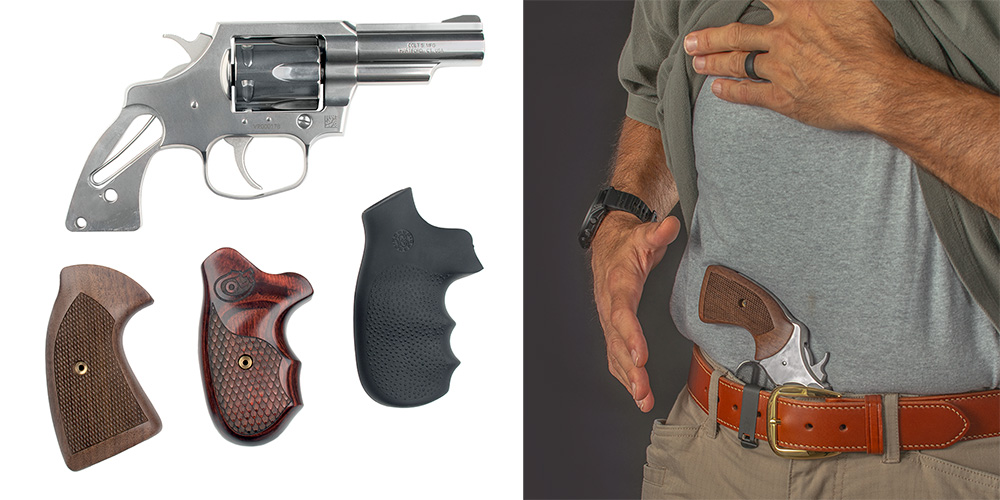
It’s interesting how things play out. Last month I reviewed a 4-inch-barreled, medium-frame .357 Mag. revolver, which is about the platonic ideal for a do-it-all handgun. It’s a little large to conceal, but the trade- off is that you’ve got a handgun that shoots well and can chamber anything from 180-grain hardcast .357 Mag. capable of stopping bears to .38 Spl. wadcutters for plinking and punching holes in paper. Take that revolver, though, trim a bit off the grip and a little bit more off the barrel, and you have the last, final evolution of the fighting revolver.
Coincidentally, I began my self-defense journey with a .357 Mag. revolver as my first purchase: a Ruger Security-Six. I didn’t really think things through, though, because a 6-inch-barreled revolver is rather hard to conceal effectively. My next attempt was a Smith & Wesson Model 19 with a 4-inch barrel, which was easier to conceal than the Ruger, but had a square-butt grip and ran the risk of “printing” in warmer months (New England winters offer a lot of cover-garment options.) The next step was significantly smaller: A Smith & Wesson Model 360PD, a 12-ounce J-frame made out of whispers and pain (that’s what it feels like when you pull the trigger). It’s super-easy to carry—the 360 is small and quite light—but man, that thing hurts to shoot. On more than one occasion I’ve offered it to friends to try it out, only to have it handed back after exactly two rounds: They have to fire a second round, because they’re certain the first round had too much powder in it.
After this, I found myself gravitating to striker-fired pistols for concealed carry, but I remain to this day a huge fan of .357 Mag. revolvers, mostly classic Smith & Wessons and Colts. Of course, a 3- or 4-inch-barreled, medium-frame .357 Mag. revolver is still a great option for concealed carry—after all, that chambering in a revolver with a round-butt and a 3-inch barrel was the ultimate revolver issued to FBI agents before semi-automatics took over the law enforcement world. For the concealed-carry practitioner confident in their gear and abilities, there’s not a lot that a compact double-action revolver can’t do.

And, when it comes to double-action revolvers, Colt has been on a roll lately. First, it resurrected the Cobra and King Cobra, then the Python and Anaconda and now, the subject of this review, the Viper. Available in two barrel lengths—4.25 inches and the 3-inch version we have here—the Viper joins the Cobra and King Cobra in being designed with the concealed-carry practitioner in mind. Slightly smaller grips and shorter barrels mean the Viper is easier to tuck away, and the shortened ejector-rod shroud and front sight are hints of the Viper’s possible role as a concealed-carry handgun.
It’s a bold strategy for Colt, really. Small-frame, five-shot revolvers are—or at least were—seemingly the last holdouts for the wheelgun in the modern world, and introducing a six-shot, stainless steel, mid-size revolver isn’t what I’d expect. Not that anyone asked me, but if I were going to resurrect something from Colt’s past, I’d be all over an updated Detective Special, which would give six shots instead of five in a package indistinguishable in size from a J-frame or LCR. Make it out of aluminum or exotic metal to keep the weight down, give it the excellent trigger for which Colt revolvers are known; man, that’d be something. However, Colt seems to be bringing back the “snake” guns first, so the Viper it is, and there’s a pretty strong case to be made for the Viper as a CCW staple.

If the Viper wasn’t specifically designed as a concealed-carry revolver, it sure turned out that way. The grip is slightly smaller than that of the Python, designed to be the same size as the Cobra and King Cobra—and, as it turns out, the same as the Detective Special, for a long time the main rival to the J-frame series from Smith & Wesson as a concealed-carry revolver. Sights are fixed and are comprised of a U-notch trench in the topstrap for the rear and a black ramp up front, but it can be upgraded if desired with the turn of a screw. The ejector, designed to be just long enough to eject spent cases, has a partial shroud to save weight rather than a full lug like on larger revolvers. Combine all that with a 3-inch barrel, and this is a wheelgun for everyday carry.
 Before we continue, I know there are going to be some who question why we’d suggest a revolver over a magazine-fed semi-auto. Revolvers hold less ammunition at the ready. They’re slower to reload. That round cylinder makes the gun wider than even double-stack, semi-autos. In a world where the Springfield Armory Hellcat Pro has a 17-round magazine and is smaller in every measurement than a gun like the Viper, you might wonder how a case can be made for a six-shot wheelgun as an everyday carry firearm. Really, it comes down to personal preference; there are folks out there who prefer the simplicity of operation of a revolver. Loading, while slower, is simple: Open the cylinder, drop rounds in, close cylinder. While inserting a magazine into a semi-auto’s grip is definitely faster, loading those magazines takes time and grip strength—which is also another check mark in the revolver column. Folks with limited hand strength may opt for a revolver, especially those that have trouble racking the slide of a modern micro 9 with stiff, nested recoil springs.
Before we continue, I know there are going to be some who question why we’d suggest a revolver over a magazine-fed semi-auto. Revolvers hold less ammunition at the ready. They’re slower to reload. That round cylinder makes the gun wider than even double-stack, semi-autos. In a world where the Springfield Armory Hellcat Pro has a 17-round magazine and is smaller in every measurement than a gun like the Viper, you might wonder how a case can be made for a six-shot wheelgun as an everyday carry firearm. Really, it comes down to personal preference; there are folks out there who prefer the simplicity of operation of a revolver. Loading, while slower, is simple: Open the cylinder, drop rounds in, close cylinder. While inserting a magazine into a semi-auto’s grip is definitely faster, loading those magazines takes time and grip strength—which is also another check mark in the revolver column. Folks with limited hand strength may opt for a revolver, especially those that have trouble racking the slide of a modern micro 9 with stiff, nested recoil springs.
There’s another elephant in the room, and one that my esteemed colleagues and field editors have discussed at length: muzzle energy. While all handguns are terrible with regard to “stopping power” when compared with rifles, some handgun rounds are better than others in the grand scheme of things, and for this, we’re going to need to run some numbers: Your average 9 mm round is most likely to be either a 115- or 124-grain projectile, traveling around 1,150 or 1,100 fps respectively, for muzzle energies right around 340 ft.-lbs. What about the vaunted .45 ACP? Well, your standard 230-grain projectile runs somewhere around 900 or so fps, for a muzzle energy around 425 ft.-lbs. How’s that compare to .357 Mag.? Well, a 125-grain projectile might hit 1,500 fps, for a muzzle energy of 625 ft.-lbs.—that’s quite a bit more oomph. In mainstream semi-auto cartridges, only the 10 mm hits those kinds of numbers. While there are a handful of concealable 10 mm pistols, none of them are what I’d call pleasant to shoot.
Which, incidentally, brings me back to the new Colt Viper. While full-power .357 Mag. isn’t exactly fun to shoot out of a smaller revolver, standard .38 Spl. is, which means you can practice using the lower-power .38 Spl. and avoid a whole bunch of felt recoil. The Viper has excellent balance, too: with a weight of 26.9 ounces, it’s slightly heavier than the compact- and micro-compact 9 mm striker-fired pistols so common today. Shooting mid-range .38 Spl., like a 148-grain wadcutter, there’s little recoil to speak of, while even the stoutest of .357 Mag. offerings are, if not fun, at least what could be called bearable.

But, here’s another secret of the revolver as a concealed-carry option: When I first shot the Viper, I found that the factory walnut grips and I just did not get along. With even .38 Spl. +P cartridges, the Viper had a tendency to kick more than I was anticipating, and I found it rocking back in my hand a little more than it should have—the grip did not fit my hand. A couple quick calls to some aftermarket grip manufacturers, though, and I had two options: Hogue’s excellent Monogrip single-piece rubber grip, and Altamont’s Rosewood grips with snakeskin texture. Swap out the factory offerings for the Monogrips and the Viper fit my hand like a glove, as well as dampening pretty much all recoil (I have a pretty sizeable number of Hogue rubber grips for just that reason). The Altamont grips are shorter, but thicker, so they fill my hand perfectly and also shave a bit of heft off the butt, making the Viper easier to conceal. Also, they’re simply stunning, too. With literally the turn of one screw, you can change the grips to something that fits your hand better.

Once I installed grips that fit my hand, shooting the Viper was, well, boring. Whether I was shooting hot .357 Mag. ammo or light .38 Spl., everything worked. Of course, that’s the beauty of the revolver. Under-powered ammo isn’t an issue with a revolver, and neither is a perfect grip. Revolvers also don’t get pushed out of battery in close quarters (although if the gun is grabbed such that the cylinder can’t rotate, that does the same thing). While it has been a while since I’ve tested a modern firearm of any kind that didn’t function extremely well (we really do live in a golden age right now), I wouldn’t be surprised to find a semi-auto that was finicky with one type of ammunition or another. I would be shocked to see that kind of selectivity with a revolver. And there were zero surprises with the Viper: It just plain worked.
Slightly more than 350 rounds of .357 Mag., .38 Spl. and .38 Spl. +P ammunition were fired through the Viper, with everything from jacketed soft-point projectiles to standard FMJ bullets. Other than the 158-grain .357 Mag. JSPs having quite a bit of kick, even with the recoil-taming Monogrip stocks, everything was quite controllable and accuracy at 10 yards was excellent. Accuracy was conducted in single-action, while snap drills were shot double-action. Whether shooting the Viper in double or single action, the trigger pull is smooth, without hitches and quite controllable. I’m a red-dot aficionado, so working with a plain-black front sight in a trough-style rear was a bit of a throwback, but they certainly worked fine out to 10 yards.
What’s the bottom line on Colt’s new Viper? I’ll leave it that when I first saw the news about it, especially the 3-inch version, I knew my friends who carried revolvers would be quite interested. If you are among those who prefer a wheelgun as your EDC handgun, Colt’s new Viper is pretty much a slam-dunk. It’s the Goldilocks of revolvers, really: not too big or heavy, so you can’t conceal it without a trenchcoat; nor so small and light that shooting it is an exercise in masochism. You can carry it a lot, you can shoot it a lot. Get your gear dialed in, stock up on .38 Spl. for practice, and you’re well-equipped for just about anything out there.




































